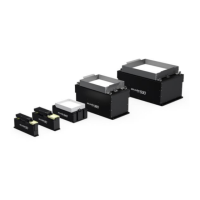16/46
5. Platform vibration
Vibration behaviour is correct when:
• The parts slide on the surface and are able to cross the platform in all directions
• The parts jump only when the ‘Flip’ vibration type is activated
The movement of the parts on the platform depends on the combination of the different
actuator excitations of the Asycube. Each actuator can be adjusted individually using the four
parameters: Amplitude, frequency, phase and waveform (signal) in order to obtain the
desired part movement. In addition, it is necessary to set the vibration duration; This setting
applies to all the actuators. The result of these settings is called a platform vibration. See
Table 5-1 for the detailed explanation of parameters.
IMPORTANT NOTE:
It is IMPORTANT to set the vibration duration as the time the parts need to completely
cross the platform in a given direction. The effectiveness of the ‘Centring' smart vibration
and ‘Vibration ratio’ duration mode depends on well-adjusted parameters.
Amplitude of the signal
sent to each actuator
and defined as the
percentage of the
maximum amplitude
Increasing the amplitude makes
the parts jump more.
The frequency of the
signal sent to the
actuators
Parts react more at a certain
frequency depending on different
factors (mass/geometry/rigidity).
Use the same frequency for all
actuators when tuning a platform
vibration.
Note: The
frequency range
depends on the
Asycube model
and the
configuration
(frame height,
etc.).
Phase shift with the
first actuator signal
(which corresponds to
the reference signal)
Actuator excitations combined
differently. Using a phase shift of
180° normally inverts the
movement of parts on the
platform.
Is defined as the
shape of the signal
A sinus waveform form
corresponds to smoother part
movement, whereas with a ramp
form the parts move more
0=no signal
1=sinus
2=ramp up
3=ramp down

